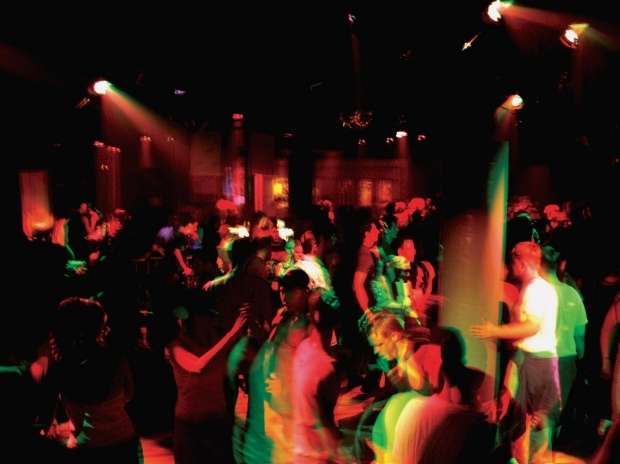Nearly half of nightclub attendees reported use of at least one of 58 new designer drugs

Novel Psychoactive Substances are synthetic or "designer" drugs which have increased in popularity in recent years. Such drugs include Foxy, Smiles, "bath salts" such as Flakka and Meow Meow, psychedelics such as NBOMe (pronounced "N-bomb" a.k.a.: "25i"), and synthetic cannabinoids (commonly referred to as Spice and K2 drugs). Many of these new drugs are marketed as "legal" highs, appearing on the drug market and out in the open in an effort to circumvent controlled substance legislation.
New street drugs continue to emerge at a rapid rate. According a recent UN World Drug Report, in 2015 alone, the emergence of 75 new drugs were detected, bringing the overall world-wide count to almost 700 "new" street drugs identified. However, in the U.S., national drug use surveys only ask respondents about their use of a couple of non-specific categories of new street drugs such as "bath salts". Furthermore, few studies in the U.S. have focused on use among one of the highest-risk populations—electronic dance music (EDM) nightclub and festival attendees.
Researchers at New York University Center for Drug Use and HIV Research (CDUHR) and Kings College London set out to rectify this dearth of information. Their paper, "Examine Correlates of New Psychoactive Substance Use Among a Self-Selected Sample of Nightclub Attendees in the United States," was recently published in The American Journal on Addictions.
"We found that among a self-selected sample of nightclub attendees in the U.S., a large range of novel substances were reported," noted said Joseph J. Palamar, PhD, MPH, an affiliate of CDUHR and an assistant professor of Population Health at NYU Langone Medical Center (NYULMC). "And, young attendees, males, and those who attended nightclubs more frequently were at increased risk of reporting use."
The data were drawn from the Global Drug Survey, led by senior author Dr. Adam Winstock, MD, founder and director of the Global Drug Survey, Ltd, which surveys tens of thousands of nightclub attendees around the world every year. The analysis focused on the 2,282 U.S. residents who reported attending a nightclub within the last year. Respondents were asked whether they have ever used 58 specific new street drugs, and the researchers examined correlates of self-reported use.
Almost half the sample (46.4%) reported ever using a new street drug, and the most commonly reported new drug used (by a quarter of the sample) was synthetic cannabinoids, commonly referred to as "Spice" and "K2" in the U.S.
"Spice drugs have been a major problem here in the U.S. in recent years," notes Dr. Palamar, "especially here in the big cities. Prevalence has dropped significantly in recent years, but antithetically, we found that nightclub attendees are still at very high risk for at least trying such products."
Trypatmines such as DMT and 4-AcO-DMT were reported used by 23% of the sample, and alarmingly, 5% reported use of the new psychedelic called NBOMe (pronounced "N-bomb").
"It's alarming that 5% of nightclub attendees reported use of NBOMe as this drug is extremely potent, dangerous, and hard to dose," said Dr. Palamar.
About one out of ten surveyed reported use of synthetic cathinones—commonly referred to as "bath salts" in the U.S. Methylone ("M1") was the mostly commonly used "bath salt" in this study with one out of ten respondents reporting lifetime use. However, the researchers caution that many club-goers may be using "bath salts" without knowing it.
"Since Molly powder is so adulterated here in the U.S., it is very likely that many respondents used bath salts unknowingly—in their Molly," said Dr. Palamar. "We actually found last year that many club-goers who reported Molly use had their hair samples test positive for bath salts".
The researchers found that more frequent nightclub attendance was strongly associated with increased risk of use of new street drugs. Attending nightclubs every week more than doubled the odds of reporting use.
"We found nightclub attendance was not related to self-reported use of synthetic cannabinoids," said Dr. Winstock. "Therefore, while synthetic cannabinoids are the most prevalent new street drug in the U.S. and worldwide, we found that these drugs tend to be used more often by individuals who do not frequent the nightclub scene."
The researchers also found that being unemployed increased the odds for reporting use of synthetic cathinones or synthetic cannabinoids.
The researchers stress that prevention and harm reduction initiatives need to be adapted to reduce the risk of harm among in this population, where increased rates of experimentation and environmental characteristics may augment and combine to increase risks associated with consuming lesser-known psychoactive substances.
The researchers also note, as the data is drawn from web surveys, there will be biases inherent in the respondents—the ones who chose to respond may be more experienced in the drug culture, and as such may not be representative of the wider population, so it is important not to interpret the findings reported as prevalence estimates.
"Every year we conduct the Global Drug Survey to help identify emerging substances and new trends in drug use," said Dr. Winstock. "The web-based design actually improves our capacity to access otherwise hidden populations to answer these kinds of questions among people who use illicit drugs."
More information: Joseph J. Palamar et al. Correlates of new psychoactive substance use among a self-selected sample of nightclub attendees in the United States, The American Journal on Addictions (2016). DOI: 10.1111/ajad.12403



















